DLL Molecular – Analytical chemistry
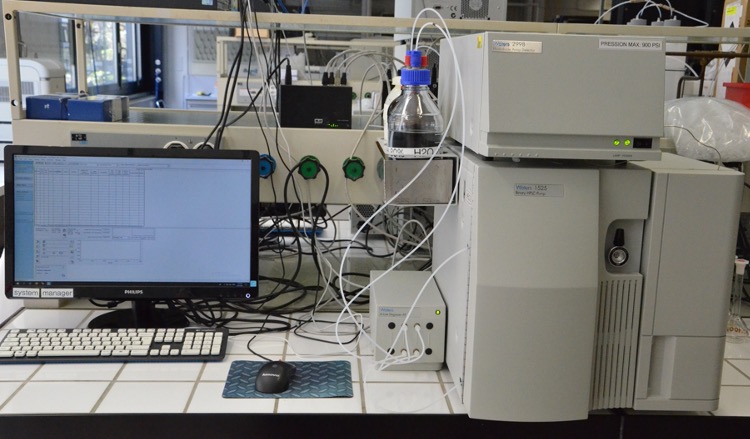
Chromatographe en phase liquide (HPLC)
The analytical DLL chemistry platform has instruments capable of separating, identifying and quantifying all kinds of chemical compounds. Depending on the nature of the sample to be measured, the corresponding method of analysis shall be selected. The list of instruments is as follows:
- Gas chromatograph (GC)
- Gas chromatograph (GC) coupled with mass spectrometer (MS)
- Liquid phase chromatograph (HPLC)
- Ionic chromatography (IC)
- Capillary electrophoresis (CE)
- Atomic absorption spectrometer (AAS)
- Energy Dispersion X-ray fluorescence analysis (EDXRF)
Facilities
Gas chromatography (GCP) is a technique that makes it possible to separate molecules of very diverse nature from a mixture that is often very complex. It applies mainly to compounds that are gaseous or capable of being sprayed by heating without decomposition. Gas chromatography (GC) is an immediate method of analysis. It makes it possible to separate the constituents from a mixture according to their sharing (by solubilization or adsorption) between two phases, one of which is stationary (solid or liquid) and the other is mobile and gaseous (carry gas).
GC Agilent model 6850
Localisation : CH B0 427
We have three devices equipped with a manual injector with the possibility of working in split or splitless mode from 70 to 350 degrees Celsius.
The furnace makes it possible to work in isotherm or in a gradient up to a maximum of 325 degrees Celsius. Possibility of mounting capillary columns only with a drum 5 inches in diameter.
The default carrier gas is nitrogen, but other gases can be used.
FID (flame ionisation detector) detector operating with a hydrogen/air and nitrogen mixture for make-up flow.
The instrument software is the OpenLab CDS.
Columns available:
HP-1: 30 m x 0.32 mm x 0.25 micron (polar column)
DB-WAX: 30 m x 0.32 mm x 0.25 micron (polar column)

GC Agilent model 6850 coupled MS model 5975C
Localisation : CH B0 427
The GC is provided with two manual injectors with the possibility of working in split or splitless mode from 70 to 350 C. The front injector is connected to the mass spectrometer with an HP-1 type column and the rear injector is connected to a FID with a DB-WAX type column.
The carrier gas used is helium.

HPLC (High Pressure Liquid Chromatography) chromatography, based on adsorption and sharing mechanisms, is mainly found in the separation of compounds with a molar mass of less than 2000 g/mol.
Breeze QS HPLC System
Localisation : CH B0 427
We have two instruments with manual injector composed of :
- degaser for two solvents
- Hand injection valve rheodyne (injection volume 20 microliter)
- Binary pump system (model 1525 binary pump) making it possible to work in isocratic or in gradient mode, the solvent mixture is done by the difference in flow rate between the two pumps. The flow rate may vary between 0.1 ml/min and 4 ml/min. Maximum use pressure: 5000 psi.
- Oven for adjusting the temperature of the column and having a stable temperature during elution.
- Photodiode array detector model 2998 (190-800) nm

As well as an instrument equipped with a sample changer and a detector with refracting index model 2414.
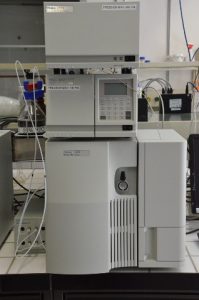
Modular dual ICS-6000 system for separating cations and anions.
This separation process is based on ion exchange processes occurring between the analytes in the mobile phase and the resin fixed to the column. Ion exchange chromatography is used to separate anions and cations from the following compounds:
– mono- and polysaccharides
– nucleosides
– nucleotides
– carboxylic acids
– organic or mineral cations and anions
The separation of the anions is carried out with an anion exchange column and the separation of the cations is carried out with a cation exchange column. The target analytes are then detected by the conductivity.
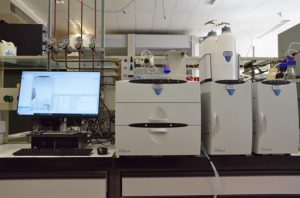
Capillary electrophoresis is a separation technique that separates molecules in an electric field according to their size and charge.
The EC is made in a glass tube called a capillary that is filled with an electrolytic solution. The analytes are separated according to their different reactions in the electrophoretic mobility, which varies as a function of the charge, the viscosity of the solvent and the size. The voltages applied for a capillary electrophoresis experiment range from 10,000 to 30,000 V.
The EC has greater resolution than high performance liquid chromatography (HPLC), which means that the separations are more efficient and more peaks can be detected. Detection is by UV absorption (180 – 300) nm directly through the capillary.
Availability of capillaries of two different diameters: 50 and 75 microns with an inside diameter.
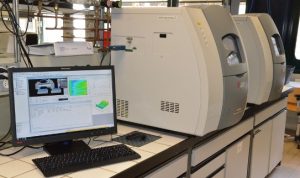
Atomic absorption spectrometry (ABS) is a technique widely used for the analysis of more than 70 elements sometimes trace. The analysis is based on the absorption of photons by atoms in the ground state and aqueous solutions in 2% nitric acid are used for this purpose.
The substances to be analysed are atomised, for example using a very hot flame (2500 K) which provides the sample with sufficient energy to break its chemical bonds. This results in a set of atoms called “atom reservoir”, some of which may be excited.
Various lamps are available for quantitatively measuring the following elements: sodium, potassium, magnesium, calcium, manganese, iron, nickel, copper, zinc.
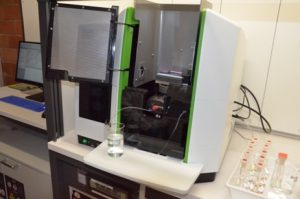
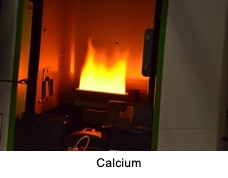
Historically, X-ray fluorescence (XRF) analysis was mainly used in geology. Today, it is established as a fundamental technology, used both in industry and in laboratories. It can detect all the chemical elements of uranium sodium.
This instrument may be used for the analysis of materials, i.e. to determine the quantity of a given substance in the sample, such as the measurement of gold content in jewellery or the detection of metallic substances in everyday objects. In addition, X-ray fluorescence makes it possible to measure the thickness of the coatings.
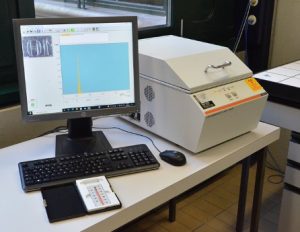
Access and safety rules
These facilities are located in the CH building:
CH B0 427
CH C0 392
Safety rules: Any person wishing to handle chemicals must be trained accordingly, in accordance with the safety rules at EPFL, the DSPS, and the rules specific to ISIC/SCGC.
Training and booking
Julien Andres, +41 21 693 74 55
Activities and courses
Chemistry and Chemical Engineering, 2024-2025, Bachelor semester 4
Experimental analytical chemistry : CH-309
UNIL – Sciences forensiques, 2024-2025, Spring semester
Analytical separation methods TP (for SFU) : UNIL-303
| Cours | Description |
| CH-309 | Experimental analytical chemistry |
| UNIL-303 | Analytical separation methods |